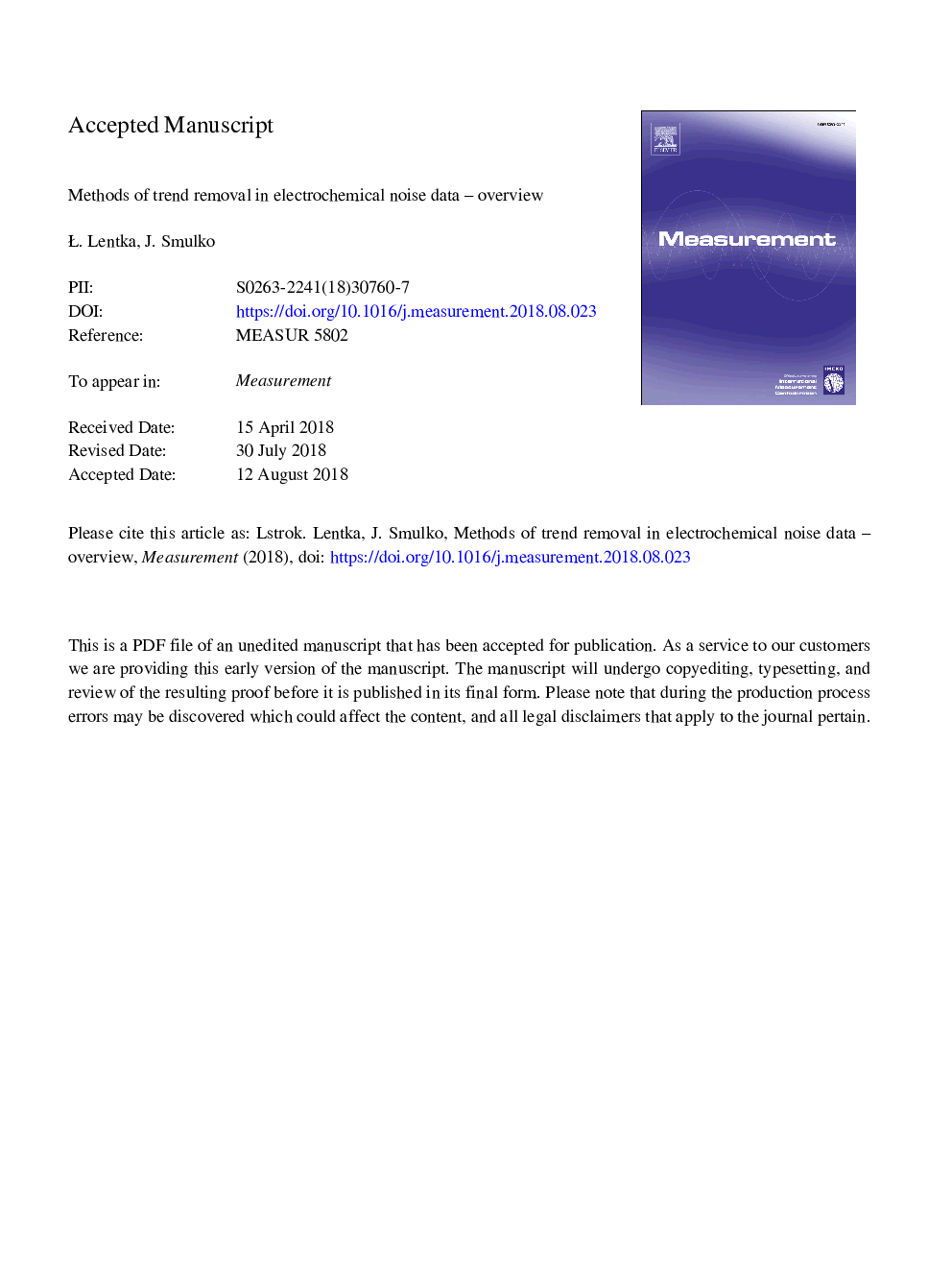| کد مقاله | کد نشریه | سال انتشار | مقاله انگلیسی | نسخه تمام متن |
|---|---|---|---|---|
| 9953693 | 1645992 | 2019 | 27 صفحه PDF | دانلود رایگان |
عنوان انگلیسی مقاله ISI
Methods of trend removal in electrochemical noise data - Overview
ترجمه فارسی عنوان
روش های حذف روند در داده های نویز الکتروشیمیایی - بررسی اجمالی
دانلود مقاله + سفارش ترجمه
دانلود مقاله ISI انگلیسی
رایگان برای ایرانیان
کلمات کلیدی
حذف روند، نویز الکتروشیمیایی، ابرخازنها، خوردگی همگن، رطوبت حرارتی،
ترجمه چکیده
در این مقاله ما روش های محبوب حذف روند از سوابق زمان نویز الکتروشیمیایی را مرور خواهیم کرد. اصول اساسی بهره برداری از شش روش محبوب ترین توضیح داده می شود. روش های پیشنهادی عبارتند از: فیلتر تصفیه آب، حذف میانگین متحرک، تکثیر چندجملهای، حذف ویولت، تجزیه حالت تجربی و تجزیه حالت اختیاری. برآورد کیفیت حذف روند با استفاده از روش های آماری مانند هیستوگرام ولتاژ صوتی، چگالی طیفی قدرت، ضریب همبستگی و قدرت سیگنال ارزیابی می شود. مزایا، معایب، محدودیت ها و برنامه های کاربردی تمامی روش های ذکر شده ارائه شده است. برای ارزیابی کارایی روش های ارائه شده، دو نمونه از داده های نویز الکتروشیمیایی با ماهیت متفاوت تولید استفاده می شود. اولین مجموعه داده های اندازه گیری در مورد نویز الکتروشیمیایی با راندگی حرارتی در اثر خوردگی یکنواخت مشاهده شد. دومین اشاره به نویز بر روی یک منحنی جریان تخلیه یک ابر مخزن است. این جزء نویز افزودنی توسط بازتوزیع شارژ یا واکنش های باززایی در الکترودهای کربن متخلخل تولید می شود. مقایسه این روشها و نشانگر مناسب ترین اجزاء برای حذف مولفه رانده از داده های الکتروشیمیایی در این مقاله خلاصه شده است.
موضوعات مرتبط
مهندسی و علوم پایه
سایر رشته های مهندسی
کنترل و سیستم های مهندسی
چکیده انگلیسی
In this paper we shall review popular methods of trend removal from electrochemical noise time records. The basic principles of operation of the six most popular methods are explained. The proposed methods are: high-pass filtering, Moving Average Removal, polynomial detrending, wavelet detrending, Empirical Mode Decomposition and Variational Mode Decomposition. Estimation of trend removal quality is evaluated using statistical measures like a histogram of noise voltage, power spectral density, the correlation coefficient and signal power. The advantages, disadvantages, limitations and applications of all of the methods mentioned are presented. Two examples of electrochemical noise data with a different nature of generation are used for assessing the efficiency of the presented methods. The first set of measurement data concerning electrochemical noise with a thermal drift were observed during uniform corrosion. The second one refers to noise superimposed on a curve of the discharging current of a supercapacitor. This additive noise component is generated by charge redistribution or redox reactions within porous carbon electrodes. A comparison of these methods and an indication of the most suitable one for removing the drift component from the acquired electrochemical data is summarized in this paper.
ناشر
Database: Elsevier - ScienceDirect (ساینس دایرکت)
Journal: Measurement - Volume 131, January 2019, Pages 569-581
Journal: Measurement - Volume 131, January 2019, Pages 569-581
نویسندگان
Å. Lentka, J. Smulko,
